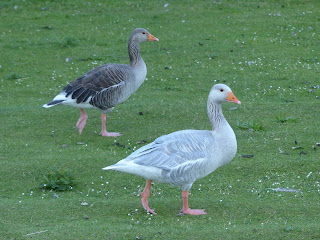Wildlife ponds
We started our walk on the wildlife ponds spotting dozens of blue damselflies. Looking at the photographs, these turned out to be Azure Damselflies.
Azure pair "in tandem"
Azure Damselfly (male)
We also saw a couple of Four-spotted Chasers and a male Banded Demoiselle. Butterflies were far and few between, with just 1 Ringlet, a Small Skipper and a female Common Blue seen.
After the insects, we also spent some time looking around the hides. Black-headed Gull chicks were everywhere, with many now fledged.
Black-headed Gull chicks
Whilst looking through the hundreds, possibly thousands of Black-headed Gulls, we were lucky enough to spot the single adult Mediterranean Gull that has spent the summer here. Can you spot the bird in this photo?
Black-headed and Mediterranean Gull
Here's a cropped picture of the bird when it had moved a few minutes later.
Mediterranean Gull
We also spotted, amongst others, Gadwall, a single adult Avocet and 4 Shelduck chicks.
Year List update:
154 - Mediterranean Gull








































